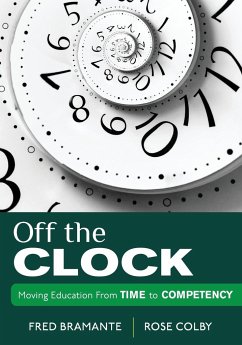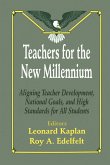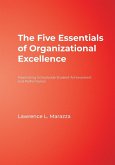- Broschiertes Buch
- Merkliste
- Auf die Merkliste
- Bewerten Bewerten
- Teilen
- Produkt teilen
- Produkterinnerung
- Produkterinnerung
How to base learning on mastery instead of time The authors not only suggest that student achievement should be based on mastering competencies instead of "seat time,&r
Andere Kunden interessierten sich auch für
![Battling the Hamster Wheel(TM) Battling the Hamster Wheel(TM)]() Grace SammonBattling the Hamster Wheel(TM)28,99 €
Grace SammonBattling the Hamster Wheel(TM)28,99 €![Battling the Hamster Wheel(TM) Battling the Hamster Wheel(TM)]() Grace SammonBattling the Hamster Wheel(TM)54,99 €
Grace SammonBattling the Hamster Wheel(TM)54,99 €![50 Ways to Close the Achievement Gap 50 Ways to Close the Achievement Gap]() Carolyn J. Downey50 Ways to Close the Achievement Gap46,99 €
Carolyn J. Downey50 Ways to Close the Achievement Gap46,99 €![Everybody's House - The Schoolhouse Everybody's House - The Schoolhouse]() Carolyn WarnerEverybody's House - The Schoolhouse39,99 €
Carolyn WarnerEverybody's House - The Schoolhouse39,99 €![Teachers for the New Millennium Teachers for the New Millennium]() Leonard Kaplan / Roy A. Edelfelt (eds.)Teachers for the New Millennium41,99 €
Leonard Kaplan / Roy A. Edelfelt (eds.)Teachers for the New Millennium41,99 €![The Whole-Faculty Study Groups Fieldbook The Whole-Faculty Study Groups Fieldbook]() Dale W. LickThe Whole-Faculty Study Groups Fieldbook44,99 €
Dale W. LickThe Whole-Faculty Study Groups Fieldbook44,99 €![The Five Essentials of Organizational Excellence The Five Essentials of Organizational Excellence]() Lawrence L. MarazzaThe Five Essentials of Organizational Excellence39,99 €
Lawrence L. MarazzaThe Five Essentials of Organizational Excellence39,99 €-
-
-
How to base learning on mastery instead of time The authors not only suggest that student achievement should be based on mastering competencies instead of "seat time,&r
Hinweis: Dieser Artikel kann nur an eine deutsche Lieferadresse ausgeliefert werden.
Hinweis: Dieser Artikel kann nur an eine deutsche Lieferadresse ausgeliefert werden.
Produktdetails
- Produktdetails
- Verlag: Corwin
- Seitenzahl: 192
- Erscheinungstermin: 14. März 2012
- Englisch
- Abmessung: 254mm x 178mm x 11mm
- Gewicht: 373g
- ISBN-13: 9781452217314
- ISBN-10: 1452217319
- Artikelnr.: 34982115
- Herstellerkennzeichnung
- Libri GmbH
- Europaallee 1
- 36244 Bad Hersfeld
- gpsr@libri.de
- Verlag: Corwin
- Seitenzahl: 192
- Erscheinungstermin: 14. März 2012
- Englisch
- Abmessung: 254mm x 178mm x 11mm
- Gewicht: 373g
- ISBN-13: 9781452217314
- ISBN-10: 1452217319
- Artikelnr.: 34982115
- Herstellerkennzeichnung
- Libri GmbH
- Europaallee 1
- 36244 Bad Hersfeld
- gpsr@libri.de
"School taught me that I was not very bright. Life taught me that school was wrong." These words epitomize the foundation for Fred Bramante's dedicated passion for transforming public education into a system that will work for virtually ever student. Fred is a former middle school Science teacher, a former candidate for governor, a life long entrepreneur, and a past Chairman and long standing member of the New Hampshire State Board of Education. Appointed by both Republican and Democratic governors, he led a full-scale effort to redesign public education, especially at the high school level, which resulted in a major revamping of New Hampshire's education regulations and the subsequent development of the New Hampshire vision For High School Redesign. Fred has been the public voice of this movement and has carried the competency-based message around the country. Fred consults with state departments of education, and national and regional associations across America. He has been a featured speaker and presenter at numerous education conferences. He holds a BS from Keene State College (1970) and an MA in Educational Leadership from Plymouth State University (2006). He has been honored to receive the Alumni Achievement Award from both Keene (1995) and Plymouth (2009). In 1964, Fred graduated 206th of 212 students in his high school; that year his applications for admission to both colleges were rejected.
Acknowledgments About the Authors Introduction: Imagine School Without Clocks Part I. Leverage: The Perfect Storm 1. Setting the Table for Transformation 2. Reform: Getting Better at Things That Don
t Work Part II. The New Hampshire Story: Mandating Flexibility: Why Leadership From the Top Matters 3. Fred
s Story 4. Rose
s Story 5. New Hampshire Present and Future Part III. The New Model for Learning: 20th Century Versus 21st Century 6. Time Versus Mastery 7. Competency-Based Learning 8. Learning in the 21st Century 9. Dropouts Versus Engaged Learners 10. Teacher Versus Educator 11. Teacher Compensation Part IV. Selling the Concept: A Conscious Effort to Create Public Demand 12. Selling to Students and Parents 13. Selling to Business, Nonprofits, and Communities 14. Selling to the Education Community and Professional Organizations 15. Selling the Concept and the Politics to Legislators Part V. Imagine the Possibilities 16. Moving Education From Time to Competency Appendix Bibliography Index
t Work Part II. The New Hampshire Story: Mandating Flexibility: Why Leadership From the Top Matters 3. Fred
s Story 4. Rose
s Story 5. New Hampshire Present and Future Part III. The New Model for Learning: 20th Century Versus 21st Century 6. Time Versus Mastery 7. Competency-Based Learning 8. Learning in the 21st Century 9. Dropouts Versus Engaged Learners 10. Teacher Versus Educator 11. Teacher Compensation Part IV. Selling the Concept: A Conscious Effort to Create Public Demand 12. Selling to Students and Parents 13. Selling to Business, Nonprofits, and Communities 14. Selling to the Education Community and Professional Organizations 15. Selling the Concept and the Politics to Legislators Part V. Imagine the Possibilities 16. Moving Education From Time to Competency Appendix Bibliography Index
Acknowledgments About the Authors Introduction: Imagine School Without Clocks Part I. Leverage: The Perfect Storm 1. Setting the Table for Transformation 2. Reform: Getting Better at Things That Don
t Work Part II. The New Hampshire Story: Mandating Flexibility: Why Leadership From the Top Matters 3. Fred
s Story 4. Rose
s Story 5. New Hampshire Present and Future Part III. The New Model for Learning: 20th Century Versus 21st Century 6. Time Versus Mastery 7. Competency-Based Learning 8. Learning in the 21st Century 9. Dropouts Versus Engaged Learners 10. Teacher Versus Educator 11. Teacher Compensation Part IV. Selling the Concept: A Conscious Effort to Create Public Demand 12. Selling to Students and Parents 13. Selling to Business, Nonprofits, and Communities 14. Selling to the Education Community and Professional Organizations 15. Selling the Concept and the Politics to Legislators Part V. Imagine the Possibilities 16. Moving Education From Time to Competency Appendix Bibliography Index
t Work Part II. The New Hampshire Story: Mandating Flexibility: Why Leadership From the Top Matters 3. Fred
s Story 4. Rose
s Story 5. New Hampshire Present and Future Part III. The New Model for Learning: 20th Century Versus 21st Century 6. Time Versus Mastery 7. Competency-Based Learning 8. Learning in the 21st Century 9. Dropouts Versus Engaged Learners 10. Teacher Versus Educator 11. Teacher Compensation Part IV. Selling the Concept: A Conscious Effort to Create Public Demand 12. Selling to Students and Parents 13. Selling to Business, Nonprofits, and Communities 14. Selling to the Education Community and Professional Organizations 15. Selling the Concept and the Politics to Legislators Part V. Imagine the Possibilities 16. Moving Education From Time to Competency Appendix Bibliography Index








